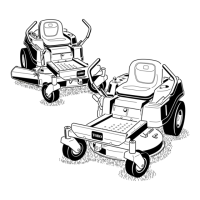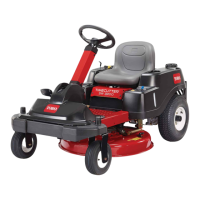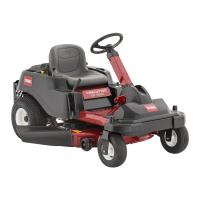Maintenance
49
Check Hydraulic Lines
After every 100 operating hours, check hydraulic
lines and hoses for leaks, loose fittings, kinked lines,
loose mounting supports, wear, weather and chemical
deterioration. Make necessary repairs before
operating.
POTENTIAL HAZARD
• Hydraulic fluid escaping under pressure
can penetrate skin and cause injury.
WHAT CAN HAPPEN
• Fluid accidentally injected into the skin
must be surgically removed within a few
hours by a doctor familiar with this form of
injury or gangrene may result.
HOW TO AV
OID THE HAZARD
•
Make sur
e all hydraulic fluid hoses and
lines ar
e in good condition and all
hydraulic connections and fittings are tight
before applying pressure to hydraulic
system.
• Keep body and hands away from pin hole
leaks or nozzles that eject high pressure
hydraulic fluid.
• Use cardboard or paper to find hydraulic
leaks.
• Safely relieve all pressure in the hydraulic
system before performing any work on the
hydraulic system.
Tire
Pressure
Maintain the air pressure in the front and rear tires as
specified. Uneven tire pressure can cause uneven cut.
Check the pressure at the valve stem after every 50
operating hours or monthly, whichever occurs first
(Fig. 38). Check the tires when they are cold to get
the most accurate pressure reading.
Pressure: 13 psi (90 kPa) drive wheels and castor
wheels.
1
m–1872
Figure 38
1. Valve
stem
Castor
Pivot Bearing
Adjustment
Check after every 500 operating hours or at storage
which ever comes first.
1. Stop the engine, set the parking brake, remove
the key and disconnect the spark plug wire(s)
from the spark plug(s).
2. Remove dust cap from castor and tighten lock
nut (Fig. 39).
3. Tighten until spring washers are flat and then
back off a 1/4 turn to properly set the pre–load
on the bearings (Fig. 39).
IMPORTANT: Make sur
e spring washers ar
e
installed correctly as shown in figure 39.
1
2
3
Figure 39
1. Spring
W
ashers
2.
Lock Nut
3.
Dust Cap

